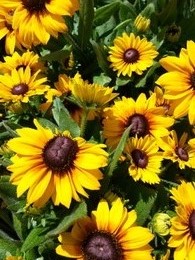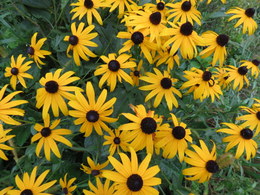Rudbeckia Growing Guide
Rudbeckia (Rudbeckia spp.) is a genus of 23-species and is in the broad Aster family. Some other common names are black-eyed Susan, brown-eyed Susan, brown betty, gloriosa daisy, golden Jerusalem, English bull’s eye, yellow daisy and yellow ox-eye daisy. It is a wildflower native to most of North America and will do well in USDA Zones 3 to 9 and prefer full sun. Depending on their native region most are herbaceous perennials, but there are annuals and biennials as well.
They bloom midsummer through fall. Depending on the variety they will reach an average height of 24 to 36-inches tall and spread 18 to 24-inches.
The species usually found in garden centers are Rudbeckia fulgida and Rudbeckia hirta with many varieties of each.
Many other Rudbeckia species are available from online sources as seed or dormant bare root plants. If you are looking for very tall flowers look at the Rudbeckia laciniata varieties that will reach heights of 5 to 8-feet!
In addition to being deer resistant they are a nectar plant for butterflies such as the Monarch, Tiger Swallowtail, Viceroy and Painted Lady. In the fall when the seed heads dry out the seeds will attract goldfinches and other songbirds as well as self-seed.
Starting from Seed
Follow the seed packet instructions, seeds can be started indoors 10-weeks before your last expected frost date.
Sow the seeds 1/4-inch deep in a sterile seed starting mix in cell packs or pots. Lightly cover with the seed starting mix and keep moist. Germination takes 14 to 21-days.
Bottom watering is the easiest way to keep moist without disturbing the newly sown seeds.
You can direct sow in your flower garden in the late spring to early summer.
For more detailed information visit the seed starting page.
Soil Preparation
Plant your Black-eyed Susans in full sun and in a nice loose well-drained garden soil and will do best in a slightly acid soil with a pH range of 6.0 to 7.0.
Planting Rudbeckia
They should be planted in the late spring after the last expected frost. Plant them 18 to 24-inches apart or in groups of 3 or 5 behind other shorter plants. Dig a hole as deep as the pot and twice as wide. To the soil you just removed add the same amount of good garden soil so you have a nice blend of new and native soil.
Take the plant out of the pot and gently loosen the root ball pulling away any roots that have grown in a circle around the pot.
Place the root ball in the hole with the growing crown of the plant even with or an inch higher than the surrounding soil. Gently spread out the roots and back fill the hole around the root ball leaving a shallow depression around your plant.
Fill the depression with water to settle the soil around the roots adding more soil if necessary and water again. Water daily tapering off as the Black-eyed Susan roots grow and get established.
Dividing Your Plants
After many years the center of the mature plant may die out, leaving the newer growth from the rhizomes. It usually becomes most apparent after a hard frost hits and the center becomes visible.
Doing the divisions every 3 to 5-years helps to rejuvenate the plant. To help prevent the spread of disease you should disinfect your garden tools and knife with a 10% bleach solution.
In the early spring about 4 to 6-weeks before the last frost date occurs and before growth begins, you can divide the clump into two, three or four sections.
Some gardeners will use a knife or a shovel to slice off a portion of the plant. A better way is to dig up the entire plant. Now you can see what you have. If you wash the soil off of the roots the entire rhizome and root structure can be seen.
Examine the rhizomes for the eyes or growing buds and carefully try to break it apart with your hands and then tease the roots apart. If necessary use a knife to separate the rhizomes.
You will now have more new plants that are identical to each other to replant or give away.
Watering and Care
Black-eyed Susans are low maintenance and easy to care for. All you need to do is add a layer of mulch to help retain moisture and keep out competing weeds. Your Black-eyed Susans should get an inch of water each week and during dry spells give them some water to keep the soil moist. They usually do not need any fertilizer, but a light side dressing of organic fertilizer can be placed around the plant in the spring.
Diseases and Pests
One of its attractive features is that there are no serious insect or disease problems.
Tips and Warnings
Remove spent blooms to encourage the production of more flowers. In the fall leave the spent blooms on, to allow the seed heads to dry for winter interest and for the birds to enjoy.
Just as new growth emerges in the early spring crowded plants can be moved and clumps can be divided to yield more plants.
Rudbeckia can spread aggressively from the production of runners or stolons, as well as self-seeding.
Popular Varieties
Rudbeckia fulgida: Deam’s Coneflower, Goldsturm, Little Gold Star.
Rudbeckia hirta: Autumn Colors, Gloriosa Daisy, Goldilocks, Indian Summer, Prairie Sun, Toto Gold, Toto Rustic.
Rudbeckia laciniata: Wild Golden Glow, Green Headed Coneflower, Autumn Sun.
Sources: American Meadows, Bluestone Perennials, Burpee
Garden Spikes newsletters give you timely information once or twice a month. Subscribe Free to the Garden Times newsletter below.
Your email address will only be used to send you a newsletter and will never be sold. You can unsubscribe at any time.


